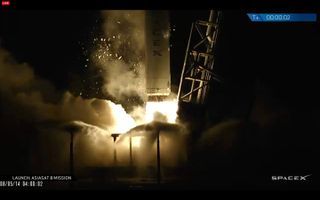
A high-powered commercial telecommunications satellite blasted into space atop SpaceX's Falcon 9 rocket early Tuesday morning (Aug. 5).
The Falcon 9 rocket, which was carrying the AsiaSat 8 spacecraft, lifted off from SpaceX's launch pad at Cape Canaveral Air Force Station in Florida at 4:00 a.m. EDT (0800 GMT) Tuesday, tracing an arc of orange flame across the dark southeastern skies on the fourth Falcon 9 flight of 2014. The launch was originally scheduled for 1:25 a.m. EDT Tuesday, but an issue with the rocket's first stage caused a 2.5-hour delay.
The launch plan calls for the rocket to deliver AsiaSat 8 to a highly elliptical "transfer orbit," but the satellite will eventually make its way to geosynchronous orbit about 22,300 miles (35,900 kilometers) above the planet. From there, AsiaSat 8 will look down on much of Asia, providing a variety of telecom services to customers in the region over the next 15 years. [Gallery: The Rockets and Spaceships of SpaceX]
"AsiaSat 8 will provide exceptional power and additional Ku beam coverage with inter-beam switching capability for services including DTH [direct-to-home] television, private networks and broadband services," representatives for the Hong Kong-based firm AsiaSat (short for Asia Satellite Telecommunications Company Ltd.) wrote in an online description of the satellite, which was built by Space Systems/Loral.
The craft "will be the most powerful member of AsiaSat's fleet, with a payload power of about 8,500 watts," the description said.
In a departure from several recent SpaceX launches, Tuesday morning's liftoff did not include a rocket-reusability test as a secondary objective.
Three times in the past year, SpaceX has tried to bring the Falcon 9's first stage back to Earth for a soft ocean splashdown. The first attempt, in September 2013, met with partial success; engineers re-lit the rocket stage's engine twice, but it spun out of control and hit the water hard.
Get the Space.com Newsletter
Breaking space news, the latest updates on rocket launches, skywatching events and more!
SpaceX put landing legs on the Falcon 9 before an April 2014 liftoff to address the spin problem, and the fix seemed to be effective. Data from the rocket showed that the stage made a soft landing in the ocean, though rough seas broke the stage apart before a recovery crew could retrieve it.
The most recent reusability test, which occurred last month during a launch for commercial-satellite firm Orbcomm, was also a success, SpaceX representatives said. Indeed, SpaceX released a video captured by a camera on the Falcon 9 first stage that shows its measured descent and controlled entry into the Atlantic Ocean.
These tests are part of SpaceX's efforts to develop a fully and rapidly reusable rocket, which the company's billionaire CEO and founder Elon Musk has said could slash spaceflight costs by a factor of 100. The next reusability trial should come on Sept. 12, during the launch of SpaceX's unmanned Dragon capsule on its fourth contracted cargo run to the International Space Station for NASA, company representatives have said.
Follow Mike Wall on Twitter @michaeldwall and Google+. Follow us @Spacedotcom, Facebook or Google+. Originally published on Space.com.
Join our Space Forums to keep talking space on the latest missions, night sky and more! And if you have a news tip, correction or comment, let us know at: community@space.com.

Michael Wall is a Senior Space Writer with Space.com and joined the team in 2010. He primarily covers exoplanets, spaceflight and military space, but has been known to dabble in the space art beat. His book about the search for alien life, "Out There," was published on Nov. 13, 2018. Before becoming a science writer, Michael worked as a herpetologist and wildlife biologist. He has a Ph.D. in evolutionary biology from the University of Sydney, Australia, a bachelor's degree from the University of Arizona, and a graduate certificate in science writing from the University of California, Santa Cruz. To find out what his latest project is, you can follow Michael on Twitter.
